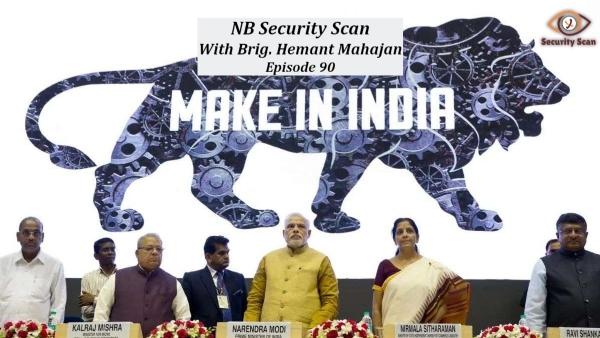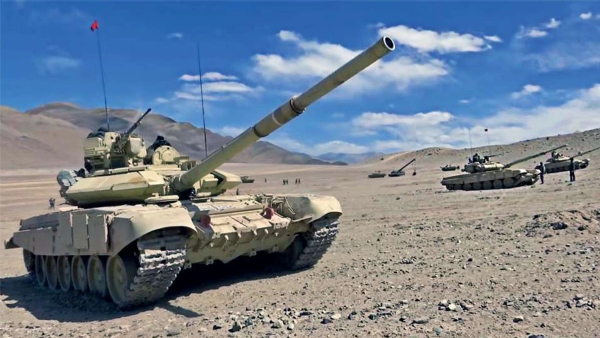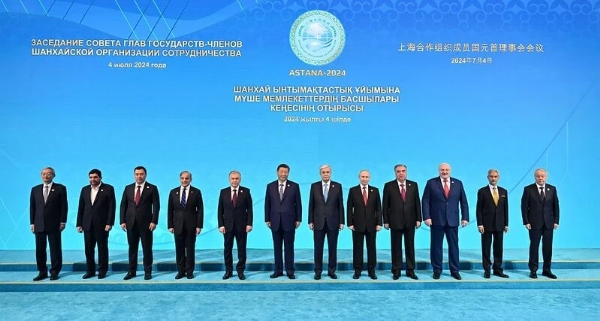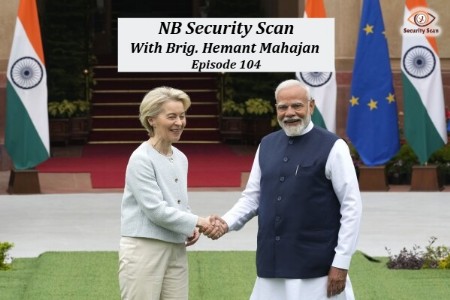Security Scan 90: India's Defence Sector, Buffer Stocks and much more
By implementing these targeted interventions, the government can not only protect the livelihoods of farmers in Punjab but also contribute to achieving the nation"s goal of food security.
Total Views | 880
This article is a summary of important events that have taken place in last one week affecting, India's national security.
Countering Internal & External Security Challenges
India's Defence Sector Reaches New Heights: A Self-Reliant Future
Record-Breaking Production Marks a Strategic Shift

India's defence sector has achieved a historic milestone. Annual defence production soared to a record high of approximately Rs 1.27 lakh crore in FY 2023-24. This surge signifies not just a quantitative leap in production, but a qualitative shift towards greater strategic autonomy and economic resilience.
"Make in India" Drives Growth and Self-Reliance
Spearheaded by the "Make in India" initiative, this growth trajectory reflects India's commitment to becoming a global defence manufacturing hub. The Defence Minister's announcement highlights the success of government policies and collaborative efforts across various sectors. The remarkable 16.7% increase in production compared to last year underscores India's dedication to indigenization and self-reliance in defence manufacturing.
Collaborative Spirit Fuels a Robust Defence Ecosystem
This achievement is a testament to the collective efforts of the Indian defence industry. Defence Public Sector Undertakings (DPSUs), other public sector units (PSUs), and private players all played a crucial role. The surge in production can be attributed to a series of policy reforms and initiatives that foster a conducive environment for defence manufacturing.
Indigenization as a Key Pillar
Over the past decade, the government has actively introduced measures to streamline processes, ease business operations, and encourage foreign direct investment (FDI). A key driver of this growth is the government's aggressive pursuit of indigenization. This focus has resulted in a significant increase in the Value of Production (VoP), with DPSUs and other PSUs contributing about 79.2% and the private sector accounting for 20.8% in FY 2023-24. This balanced growth across sectors indicates a healthy and competitive defence ecosystem.
"Make in India": Transforming the Defence Landscape
Launched in 2014, "Make in India" aims to transform India into a global manufacturing leader. In the defence sector, this initiative has been instrumental in reducing dependence on imports and driving self-reliance. The record-high production figures stand as a testament to its success. The program consistently surpasses milestones, reflecting the government's unwavering commitment to achieving "Aatmanirbharta" (self-reliance).
Defence Exports Soar, Boosting Economy and Influence
The phenomenal growth in defence exports, reaching a record high of Rs 21,083 crore in FY 2023-24 (a 32.5% increase), has significantly bolstered indigenous production. This surge not only establishes India as a reliable defence supplier but also contributes to overall economic growth. Furthermore, growth in production and exports strengthens India's position in the global defence market, enhancing its geopolitical influence.
Looking Ahead: Sustaining and Accelerating Growth
The challenge lies in sustaining and accelerating this progress. Continued policy support, investments in research and development (R&D), and fostering innovation are crucial. Developing a skilled workforce equipped to handle advanced defence manufacturing will be equally important. The private sector's role in driving innovation and efficiency will also be increasingly important. Public-private partnerships, technology transfers, and collaborations with global defence companies will be key to unlocking India's full potential in defence manufacturing.
India's Light Tank: A Step Forward, But More Needed
Zorawar Prototype Completes Development: A Positive Step
There's welcome news for India's defense establishment. The Defence Research and Development Organisation and Larsen & Toubro have successfully completed the prototype stage of Project Zorawar, India's indigenous light tank. This development is crucial in light of the ongoing border tensions with China along the Line of Actual Control (LAC).
Light Tanks: Ideal for the Himalayas

The Indian Army currently deploys heavier Russian-origin tanks like the T-90s and T-72s along the LAC. However, these tanks, weighing in at 40-50 tonnes each, are designed for flatter terrains and not well-suited for the high altitudes of the Himalayas. The Zorawar light tank, weighing around 25 tonnes, is specifically designed for mountainous terrain and will be a valuable asset.
Beyond Light Tanks: The Need for Fleet Modernization
The introduction of the Zorawar light tank only addresses part of India's tank problem. The Indian Army has a much larger fleet of aging Russian tanks nearing the end of their life spans that require replacement and modernization. The army plans to address this by issuing a Request for Proposal (RFP) this year for the Future Ready Combat Vehicle (FRCV) program. This program aims to produce 1,770 next-generation tanks in phases, beginning in 2030, to replace the T-72s.
A Looming Tank Deficit
However, with over 2,400 T-72s in its inventory, the army reportedly plans to upgrade a significant portion of them with better engines and fire control systems. This leaves a sizeable number of T-72s that won't be upgraded, potentially creating a tank deficit in the near future.
Seamless Modernization: A Strategic Imperative
The successful induction of new, advanced tanks alongside the modernization of existing ones is vital to maintain the Indian Army's firepower. While the Zorawar light tank is a positive development, India must maintain its focus on modernizing the bulk of its tank fleet.
Russia to release Indians fighting in Ukraine war after Modi-Putin talks
Russia has decided to release and return all Indians fighting for the Russian army in Ukraine, a breakthrough achieved after Prime Minister Narendra Modi raised the issue with President Vladimir Putin during his Moscow visit.
The development came after Prime Minister Modi, who is in Moscow for a two-day visit, raised the matter at a private dinner hosted by Putin on Monday evening.
Nearly two dozen Indians are believed to have been forced into fighting the war against Ukraine after being tricked by agents into going to the country on the pretext of getting high-paying jobs.
"Strong action has been initiated against agents and unscrupulous elements who recruited them on false pretexts and promises.
Four Indians have been killed in the war, while 10 have returned to the country. About 35–40 Indians are still believed to be stuck in Russia.
Stalemate at the Himalayas: India-China Talks Yield No Concrete Progress
Déjà Vu at the Shanghai Cooperation Organisation Meeting

Recent talks between External Affairs Minister S Jaishankar and his Chinese counterpart Wang Yi promised a "redoubling of efforts" to resolve the ongoing border standoff in eastern Ladakh. However, this declaration rings hollow in light of similar unfulfilled commitments made during the prolonged dispute. Their pronouncements seem more like platitudes than a genuine push for progress.
Building on the Border: Infrastructure Race and Strategic Villages
The deep-seated distrust between the two nations is evident in their competitive development of border villages. India's decision to establish settlements closer to the LAC mirrors China's strategy of building over 600 "prosperous villages" (Xiaokang) along the border. These villages serve a dual purpose – bolstering territorial claims and enhancing military preparedness.
India's countermeasure, the ambitious Vibrant Villages Programme, aims to improve infrastructure and amenities in border areas. This initiative, encompassing nearly 3,000 villages, has a strategic objective: to empower villagers to act as sentinels for the Indian army.
The current trajectory suggests a continuation of the status quo – a tense standoff punctuated by unfulfilled promises of progress
CROWD SECURITY:Preventing Future Stampedes After Hathras
A Cycle of Tragedy and Missed Opportunities
The recent stampede in Hathras, claiming over 120 lives during a religious gathering, tragically underscores our national failing: the inability to learn from past disasters. These events are often met with knee-jerk reactions and temporary fixes, followed by a return to complacency until the next catastrophe strikes. Our policies lack the urgency for long-term, proactive measures to prevent such avoidable tragedies.
The Naina Devi Stampede: A Cautionary Tale Unheeded
The 2008 Naina Devi temple stampede, where 146 devotees perished due to a landslide rumor, serves as a stark example. While some improvements were made in crowd control – like implementing a batch system for pilgrims and enhancing safety measures – the story doesn't end there. Many recommendations from the investigative committee remain unimplemented, even after 16 years.
Leadership in Crisis: Empathy, Accountability, and Action
Offering substantial compensation to victims' families is a crucial aspect of leadership during crisis – it demonstrates empathy and a sense of accountability. Regardless of political affiliation, a thorough investigation into administrative lapses is essential to ensure justice and prevent similar occurrences.
Building a Robust Safety Net: Strategies for Effective Crowd Management
Moving forward, authorities must prioritize robust crowd management strategies. These include adhering to venue capacity limitations, implementing effective emergency response plans, deploying sufficient security and medical personnel, and utilizing real-time monitoring through CCTV cameras and clear communication channels.
We owe it to the victims of these stampedes to ensure their deaths are not in vain.
DIGITAL SECURITY: The Rise and Fall of Koo: A Cautionary Tale for Indian Startups
A Promising Start: A Local Voice in a Globalized World

KOO, once touted as the Indian Twitter alternative, has shuttered its doors after battling a challenging funding environment. Launched in 2020 by Aprameya Radhakrishna and Mayank Bidawatka, Koo aimed to empower Indian users to connect in their native languages, potentially disrupting Twitter's hold on the Indian market. The platform garnered early promise, boasting 2.1 million daily active users at its peak.
Riding the Wave of Digital Nationalism
KOO's launch coincided with India's push for "Atmanirbhar Bharat" (Self-reliant India) in the digital space. It gained significant traction during a government-Twitter standoff over content regulation. High-profile figures, including government officials and celebrities, flocked to the platform, giving it an air of legitimacy. The vision of a hyper-local, multilingual social media space resonated with many users seeking a platform that catered to their linguistic preferences.
Stumbling Blocks: Political Leanings and Funding Challenges
However, Koo's journey wasn't without roadblocks.The platform faced criticism for becoming a haven for right-wing discourse, which alienated a significant portion of potential users. Additionally, Koo's over-dependence on external funding proved to be a critical weakness. The prolonged funding winter and failed acquisition talks with major internet companies severely hampered its ability to sustain operations.
Funding Woes and Market Pressures: A Recipe for Failure
Despite securing $30 million in funding led by Tiger Global, Koo struggled to maintain its growth momentum. The platform's technical prowess and user-centric design couldn't overcome the challenge of attracting a user base large enough to offset operational costs. Coupled with a harsh market environment, this ultimately led to Koo's demise.
A Sobering Reminder for Aspiring Start ups
KOO's shutdown serves as a cautionary tale for aspiring Indian start ups. Its story highlights the crucial role of sustainable funding models, the need for market adaptability, and the immense difficulty of dethroning established tech giants. As Radhakrishna and Bidawatka bid farewell, Koo's legacy will be remembered as a bold experiment and a sobering reminder in the ever-evolving Indian digital landscape
FOOD SECURITY-
Taming Food Price Volatility: The Case for Buffer Stocks
Maintaining Orderly Food Markets: Learning from the RBI
The Reserve Bank of India (RBI) manages foreign exchange reserves to ensure "orderly" fluctuations in currency exchange rates, not to dictate market prices. A similar approach is necessary for essential food items. The government should establish buffer stocks not only for staples like rice and wheat, but also for pulses, oilseeds, sugar, skimmed milk powder (SMP), and even key vegetables.
The primary goal is not to control prices or undermine the market, but to mitigate excessive price volatility that harms both consumers and producers. Volatile food prices complicate the RBI's monetary policy decisions. For instance, how should the central bank respond when core inflation (excluding food and fuel) is low, but food inflation remains high? Buffer stocks can help alleviate this dilemma.
Climate Change and the Vicious Cycle of Food Price Swings

Climate change is a major culprit behind rising food price volatility. Erratic weather patterns, including fewer rainy days, intense precipitation, shorter winters, and heat waves, disrupt agricultural production. These disruptions lead to supply shocks, causing sharp price spikes. Farmers then ramp up production in response, leading to oversupply and price crashes.
The dairy industry exemplifies this cycle. Last year, milk prices for farmers were high. However, a recent crash in SMP prices has led to drastically lower procurement prices for milk, potentially leading to milk shortages and inflation next year.
Buffer Stocks: A Solution for Smoother Markets
Creating buffer stocks of essential food items can help mitigate these extreme price fluctuations. The government can procure excess produce during years of surplus and release it during times of scarcity. The fiscal cost can be minimized by storing certain items like potatoes, onions, and tomatoes in dehydrated forms like flakes, pastes, or purees. These stocks can then be sold at near-market rates during periods of scarcity or inflation.
The government's previous use of open market sales for wheat and chana demonstrates the effectiveness of this approach in moderating food price inflation. Furthermore, buffer stocks can eliminate the need for regressive policies like export bans or stockholding restrictions on private traders, which ultimately harm farmers.
In conclusion, implementing a buffer stock system for essential food items is a crucial step towards ensuring stable food prices and a more resilient food system in the face of climate change and other challenges.
Farmers Hit by Unfulfilled Procurement:
The Punjab government's failure to live up to its promise of procuring moong dal this year has left farmers in a difficult situation. They are forced to sell their produce to private companies at prices lower than the Minimum Support Price (MSP) set by the government, which is currently Rs 8,555 per quintal. A similar pattern emerged in 2022 when Chief Minister Bhagwant Mann had promised government procurement of moong dal at MSP.
Targeted Interventions for Food Security:
By implementing these targeted interventions, the government can not only protect the livelihoods of farmers in Punjab but also contribute to achieving the nation's goal of food security, ensuring citizens have access to the nutritious food they need.
INTERNATIONAL RELATIONS
A New Direction: Keir Starmer's Approach to India-UK Relations
With the recent change in leadership following the UK elections, Keir Starmer has taken over as Prime Minister, marking a potential shift in UK-India relations after years under Conservative rule.
Past Strains and Current Outlook on Kashmir
Under Jeremy Corbyn, Labour's stance on Kashmir strained ties with India, but Starmer has sought to repair this damage, emphasizing that India's internal matters, including Kashmir, should be resolved bilaterally.
Challenges of Khalistan Sympathies in Labour

Despite efforts to mend relations, Starmer faces challenges from MPs sympathetic to Khalistani separatists, posing a potential obstacle to bilateral cooperation.
The Road to a Free Trade Agreement
Negotiations for a Free Trade Agreement progress, but differing views on skilled labor mobility could complicate talks. Balancing economic benefits with immigration concerns is crucial.
Economic Revival and Domestic Priorities
Starmer's focus on post-Brexit economic recovery and domestic issues like immigration will influence his approach to international relations, including those with India.
Future Prospects: Navigating Complexities
Starmer's pragmatic approach offers hope for improved India-UK relations, contingent on addressing internal party dynamics and trade negotiations effectively.
India's Foreign Policy Priorities: A Multifaceted Approach
US Elections and India's Strategic Partnerships
While the formation of a new Indian government led by Prime Minister Modi is a domestic development, the ongoing US presidential election campaign has global implications. The rivalry between President Biden and his predecessor Donald Trump casts a shadow of uncertainty, particularly considering their contrasting stances towards India.
India's strong ties with US Secretary of State Antony Blinken and National Security Advisor Jake Sullivan provide a foundation for smooth relations regardless of the election outcome. The appointment of Vikram Misri, an experienced diplomat with exposure to both the US and China, further strengthens India's ability to navigate complex international relations.
Building a Strong and Peaceful Neighborhood
India's primary foreign policy focus remains on fostering a secure and peaceful neighborhood, particularly in the strategically important region stretching from the Strait of Malacca to the Strait of Hormuz.
Shifting Tides in US-India Relations
Despite President Trump's personal rapport with PM Modi, the recent US State Department statement expressing concern about human rights in India highlights potential friction during a Biden administration. This underscores the importance of PM Modi's upcoming meeting with President Putin, who has consistently maintained friendly relations with India.
Beyond Bilateral Ties: India's Expanding Partnerships

Despite these shifting dynamics with the US, India's overall foreign policy trajectory reflects a growing network of partnerships. Bipartisan support in the UK and deepening ties with both Labour and Conservative parties showcase this trend. Similarly, strengthening relations with France and Germany illustrate Europe's increasing engagement with India.
Countering China's Influence: A Global Challenge
India's growing ties with the US and other powers are viewed in the context of China's rising influence. India remains vigilant against Chinese attempts to undermine its security and economic interests, particularly in its immediate neighborhood.
The EU's complex relationship with China, viewing it as both a partner and a rival, underscores the challenges of navigating a world with multiple power centers. While the EU is unlikely to offer significant military assistance against China, diplomatic cooperation remains a possibility.
India's Strategic Role in Asia
India's support for the Philippines through the BrahMos missile deal exemplifies its role in countering Chinese aggression in the region. India also needs to remain vigilant against China's efforts to gain access to ports in South Asian nations, potentially jeopardizing Indian security interests.
Ensuring Regional Security
India has also skillfully navigated the complex Israel-Hamas conflict, prioritizing its strong relationships with Gulf countries where a significant Indian diaspora resides.
Looking Ahead: Building on Achievements and Facing Challenges
India's foreign policy achievements are commendable. However, maintaining a firm stance against the China-Pakistan axis, a major threat to Indian security, remains crucial. By building on its existing partnerships and strategically navigating the evolving global landscape, India can ensure its continued rise as a major world power.
--
Bharati Web








